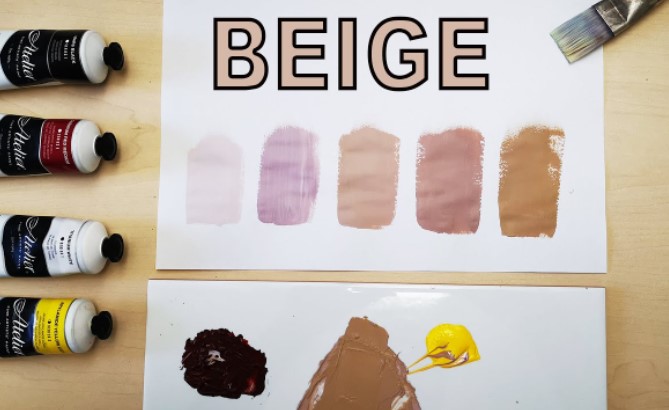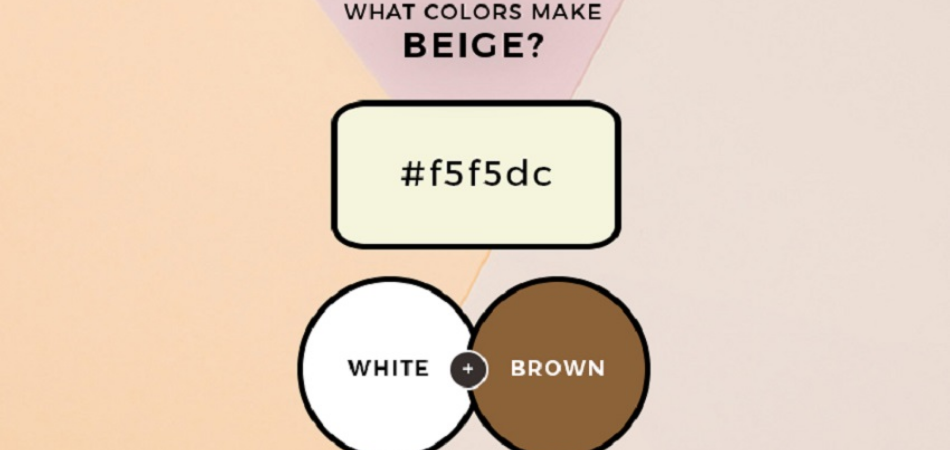Randy Charles is the owner of PaintCentric.com, a website dedicated to providing information, tips, tricks, and news about all things paint. With over 10 years...Read more
Create beige paint? Have to mix the colors right. First step: gather materials. Need red, blue, yellow, and white paint. Plus, get a mixing tray, paintbrush, and palette knife. These tools help you make the perfect beige shade for your project.

Gather the necessary materials
Gather all the necessary materials for the perfect beige paint. Start by selecting three base paints – a warm yellow-based hue, a cool bluish-based hue, and a white base. Choose different colors for variation and texture.
Next, choose a clear medium like linseed oil or mineral spirits to thin out the colors. Make sure to thin them out equally for smooth mixing. Get an accurate measuring device like a syringe for measuring each color before combining.
Gather other materials like gloves and stirring tools. Getting your desired shade may take some time, so be patient!
Measure out the paint pigments.
To make beige paint, gather the necessary components: titanium white, bronze yellow and sienna pigments. Measure out enough of each to get your desired shade. Mix them together in a container until they form a uniform color. Stir carefully. Use a hand blender or spatula for an even consistency.
Consider how much white pigment to use relative to other pigments. You may need more or less white pigment to lighten or darken the hue. Experiment with different ratios until you get it just right!
Mix the pigments with a paint binder.
Choose colors. Create a chart. Mix them equally. Note the results. Get the desired shade.
Mix pigments with a paint binder. Oil, eye-diluting liquids or latex. Depends on the paint type.
- Oil-based paints are best for inside walls.
- Latex paints are best for outside surfaces.
Mix each pigment thoroughly into the binder. Use a paint stirrer or electric mixer. No lumps. Achieve a homogeneous paste. Repeat several times.
Ensure reliable results when applying the Beige: brush or roller.
Applying the Paint

Have you got the materials and tools for beige paint? Now it’s time to apply! Painting walls or other surfaces is key for the perfect color and finish. Let’s break down the basics of the application. Knowing the process is essential for the best results.
The basics of the application include the following:
- Preparing the surface
- Mixing the paint
- Applying the paint
- Cleaning up
Prepare the surface for painting
Paint like a pro! Start by preparing the surface by cleaning off dust or dirt. If there are cracks or chips, fill them with plaster or putty. Mask any areas that need extra protection, such as pulls on window handles or fan blades.
Beige paint is a popular choice for soft, neutral looks. Use a brush for precision application when cutting in. Use a small roller for an even coating with fewer brush strokes for large, flat surfaces. Latex is best for beige paints, as it dries quickly and covers dark colors better.
Apply a primer coat
Assess the surface before mixing beige paint. Look for paint that is cracked or peeling and remove it. Then, use sandpaper to make the surface smooth.
After that, apply an even primer layer with a brush or roller. Cover all areas completely and leave them to dry. Then, you’re ready to begin your painting project.
Apply the beige paint in thin coats.
When ready to paint, check the wall for dust and dirt. If needed, use a damp cloth to remove it. Make sure the area is evenly lit.
Stir the beige paint gently but thoroughly with a wooden stick. This helps even color and adhesion. Remember, light colors need more coats.
Apply paint starting in one corner. Work in sections from side to side and top to bottom. Use light strokes with even pressure. Each coat should be as thin as possible.
Allow drying time of 30 minutes – 24 hours. After drying thoroughly, sand all areas with extra fine (240) sandpaper. Seal with varnish or wax for protection.
Finishing Touches
Give your beige paint the perfect finishing touch with highlights and shadows. These will give a more realistic 3D effect. Sponging, dry-brushing and glazing are techniques that can help achieve this.
Let’s explore how these techniques can make your beige paint look stunning!
Allow the paint to dry completely.
Paint must dry for at least 24 hours before you apply a finish. When it’s all dry, you can add a finish. Different types of finishes are available, depending on the desired finish, durability, and protection. For example, water-based polyurethane varnishes are good for internal woodwork items like furniture and trim. Oil-based products work best on external wooden surfaces like doors or stairs.
Using a paint sprayer, use low pressure to access hard-to-reach areas. But be careful not to ‘blob’ the spray away from the painted surface. Blobbing causes uneven paint distribution, leading to imperfections on the finished surface. Instead, move your hand steadily while holding the spray gun. Allow some overlap, too, so that more than one coat can be applied if necessary.
Ventilate the area properly so fumes from finishes can escape. Open windows and use exhaust fans, if available. Don’t rush. Take your time for the best results! Leave enough time between coats for good adhesion. This will help prevent cracking or delamination down the line.
Sand the surface with a fine-grit sandpaper

Sanding is essential for a successful beige paint job. Even if you assume the piece is already sanded, use fine-grit sandpaper (150-grit) to remove saw marks, scratches and dust. Use light circular strokes across all surfaces to make it smooth and uniform. Pay attention to corners, edges and any cracks.
Once done sanding, use a cloth or vacuum hose to remove dust particles so that nothing gets in the way of the paint job.
Apply a sealant to protect the paint.
Once you’re done with the beige paint, don’t forget to apply a sealant. This helps protect it from chips, scratches, and wear and tear.
Choose between wax-based sealant or polyurethane sealant. Wax-based sealants add more color but may turn yellow over time. Polyurethane is more durable and gives the surface a flat look, but it is harder to remove.
Make sure the paint is dry before applying sealant. Follow the instructions on the can for the best results. Use multiple thin layers with light sanding in between. This way, you won’t have brush strokes or excess product. You may need to apply a second coat of sealant if you use a wax-based product or one with fewer coats.
Frequently Asked Questions
What colors do I need to make beige paint?
To make beige paint, you will need white paint and yellow paint. You can mix the two to create a beige color.
How much white paint and yellow paint do I need?
The exact ratio of white to yellow paint will depend on the shade of Beige you want to create. A good starting point is to mix 1 part of yellow paint with two parts of white paint.
What kind of paint should I use?
Any paint should work, including acrylic, latex, or oil-based paint. If you are unsure which type to use, consult a local paint store for more information.

Randy Charles is the owner of PaintCentric.com, a website dedicated to providing information, tips, tricks, and news about all things paint. With over 10 years of experience in the painting industry, Randy has become an expert in the field and is passionate about helping others learn more about painting. He has written numerous articles on the subject and is committed to providing accurate and up-to-date information to his readers.
- Latest Posts by Randy Charles
-
How Much Do You Tip Painters? The Ultimate Guide
- -
Can You Paint Over Rust Converter?
- -
Can You Paint Inside When It Is Raining?
- All Posts
